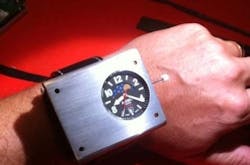Cesium atomic optical wristwatch is entirely self-contained
Kapaa, HI--The wristwatch enthusiast's website watchuseek is reporting that Bathys Hawaii, which produces specialist watches for use in extreme environments, has created a wristwatch based on an entirely self-contained cesium atomic optical clock. Such clocks use a laser to stimulate a hyperfine transition of ground-state cesium-133.
The watch was created by watchmaker John Patterson and engineer George Talbot, according to watchuseek.
Accurate to 1 s per 1000 years
“The technology found in this watch is something even a decade ago no one could imagine existing in such a small package,” says Patterson. “Within a single chip there is a laser, a heater, a sealed cavity of cesium gas, a microwave filter, and a photodiode detector. Using the exact same principle of counting hyperfine lines of excited cesium-133 atoms used by the National Institute of Standards and Technology (NIST), our watch is able to achieve unprecedented levels of accuracy: on the order of one second per thousand years.”
The new watch is called the “Cesium 133.” As explained on watchuseek, "Unlike so-called 'atomic wrist watches' that use a radio signal generated by the U.S. government to keep accurate time, this new watch has its own self-contained cesium source that generates the time signal independently."
The watch is only a prototype, as is made obvious by its large size of 60 x 50 x 23 mm; Patterson will be working to reduce its size, as well as extend its battery life. The aim is to produce a limited edition of 20 watches in 2014, selling at $12,000 each.
There are other types of atomic optical clocks that beat cesium clocks in accuracy, such as strontium clocks; however, they don't yet fit on the wrist.

John Wallace | Senior Technical Editor (1998-2022)
John Wallace was with Laser Focus World for nearly 25 years, retiring in late June 2022. He obtained a bachelor's degree in mechanical engineering and physics at Rutgers University and a master's in optical engineering at the University of Rochester. Before becoming an editor, John worked as an engineer at RCA, Exxon, Eastman Kodak, and GCA Corporation.
